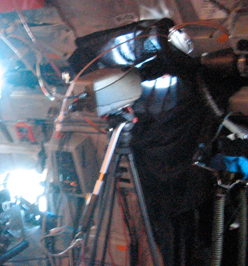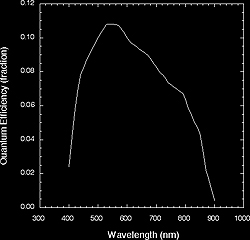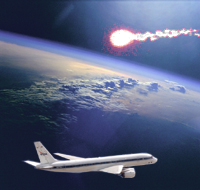|
HFRS - High Frame Rate Spectrograph
Instrument P.I.: Matthew Geoff Mcharg, United States Air Force Academy.
The information below will be updated as more precise data is received.
Technique: Intensified high-speed imaging and slit-less spectroscopy.
Scientific objective: Provide spectral (and imaging) information at a rate of 1000 frames per second for detection of ablation anomalies, flicker in bowshock emissions, spacecraft rotation, and wake.
 Instrument: The instrument consists of a digital intensified CCD camera capable of 1000 frames per second, equipped with a 600 l/mm objective transmission grating.
Instrument: The instrument consists of a digital intensified CCD camera capable of 1000 frames per second, equipped with a 600 l/mm objective transmission grating.
Heritage: This camera was deployed during the Genesis SRC entry observing campaign. Stored away for takeoff and landing. No rack requirements.
Aircraft hardware requirements: Window swivel mount. Electricity at window. Stow box.
Instrument validation tests: This camera has been used in past missions and was tested during ground-based field campaign in June and July 2005.
Sensitivity: T.B.D.
Dynamic range: 12-bit (factor 256).
Frame rate and exposure times: Exposure time: 1/1000s.
Spectral resolution - gives the FWHM of an instrument-broadened unresolved atomic spectral line:
In first order: 2 nm. Provides spectra covering 170 nm wavelength range within the spectrographs range of 450 to 900 nm, depending on position of the SRC source. We expect most data in the range 640 to 810 nm.
Relative spectral response - gives the wavelength dependence of the combined system (window, lens, spectrograph, and CCD camera). The Quantum Efficiency of the system depends somewhat on the angle of viewing through the window (window absorption at the near-UV cut-off). Values need to be multiplied by cos(angle), with angle the viewing angle of the camera away from the position of the Sample Return Capsule (t.b.d., graph to be updated):

wavelength: Quantum Efficiency:
(nm) (fraction)
400.0 0.024
410.0 0.041
420.0 0.058
430.0 0.068
440.0 0.078
450.0 0.083
460.0 0.086
470.0 0.090
480.0 0.094
490.0 0.097
500.0 0.100
510.0 0.103
520.0 0.106
530.0 0.108
540.0 0.108
550.0 0.108
560.0 0.108
570.0 0.108
580.0 0.105
590.0 0.102
600.0 0.100
610.0 0.097
620.0 0.096
630.0 0.095
640.0 0.094
650.0 0.093
660.0 0.091
670.0 0.090
680.0 0.087
690.0 0.085
700.0 0.083
710.0 0.080
720.0 0.079
730.0 0.076
740.0 0.074
750.0 0.072
760.0 0.071
770.0 0.070
780.0 0.069
790.0 0.068
800.0 0.064
810.0 0.059
820.0 0.055
830.0 0.050
840.0 0.047
850.0 0.044
860.0 0.034
870.0 0.022
880.0 0.017
890.0 0.010
900.0 0.004
|










 Instrument: The instrument consists of a digital intensified CCD camera capable of 1000 frames per second, equipped with a 600 l/mm objective transmission grating.
Instrument: The instrument consists of a digital intensified CCD camera capable of 1000 frames per second, equipped with a 600 l/mm objective transmission grating.
